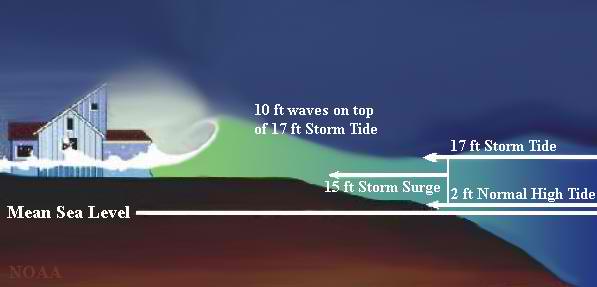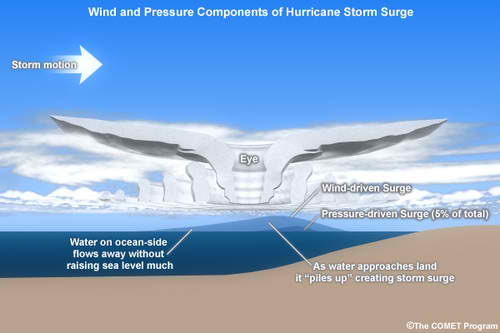Our hearts go out to everyone affected by the wrath of Typhoon Yolanda (Haiyan). In a way, we know the feeling, as we were also devastated by Ondoy more than four years ago. However, I would have to admit that Ondoy looked like a very tame typhoon compared to Yolanda, which is many times deadlier because of its storm surge. Question is, do we really know what a storm surge is?
What is a storm surge?

Wikipedia defines a storm surge as:
“A storm surge is an offshore rise of water associated with a low pressure weather system, typically tropical cyclones and strong extratropical cyclones. “
In the same wikipedia page, it also states something which I wish were not true, but sadly, is exactly what we have seen:
“Most casualties during a tropical cyclone occur during the storm surge.”
How is a storm surge created?

The storm surge is created by wind, waves, and low pressure
There are three mechanisms that contribute to the storm surge:
1. The action of the winds piling up water (typically more than 85% of the surge).
2. Waves pushing water inland faster than it can drain off. This is called wave set-up. Wave set-up is typically 5 – 10% of the surge.
3. The low pressure of a hurricane sucking water higher into the air near the eye (typically 5 – 10% of the surge).
Source: NOAA via wunderground.com
Storm surge video animation

Actual footage of a storm surge in Hernani, Eastern Samar
This video footage of a storm surge destroying a house was taken last November 8, 2013, by Plan International staff member Nickson Gensis. He took the video while sheltering on the 2nd floor of a house less than a few hundred meters from the sea in Hernani, Eastern Samar, Philippines.

What is storm surge in tagalog?
The term storm surge in tagalog is “daluyong ng bagyo”.
Why is a storm surge so dangerous?
From stories of survivors like Lieutenant Colonel Fermin Carangan, we can see how flood waters can rise very quickly because of a storm surge, which can be a big problem if you are caught inside a building that only had one floor. Add strong winds to that and you have a recipe for a catastrophe.
In Atom Araullo’s live report below, footage taken at 7:25am at downtown Tacloban City shows how the storm surge suddenly rose and was knee-deep in a matter of minutes, and reached about 10 feet later on.

But the worst was yet to come.
The storm surge was expected to peak at around 11:00am with a height of 14.76 feet (4.5 meters) in Tacloban City, according to the Official list of localities: Typhoon Yolanda highest predicted storm surge and tides from the Project Noah website. Some eyewitnesses say the storm surge reached up to 3-stories high.
So if one is able to hide from the strong winds, you can’t hide from the storm surge if you are in low-lying areas. As stated earlier in this post, “Most casualties during a tropical cyclone occur during the storm surge”.
How to survive a storm surge?
People who survived Katrina’s storm surge did one of several things: they floated out an open window, and managed to hang onto debris, a tree, or some other structure above the water, until the surge receded, hours later. Or, they were able to pull themselves into an attic, or make it up to a second floor, where water did not reach, and luckily the home was not swept away. It is common in many flood-prone regions behind levees to keep an axe fastened to the wall of the attic. Then, if water comes in unexpectedly, you can get into the attic and chop a hole through the roof to escape. Don’t forget to keep a length of rope there that you can use to tie yourself to a sturdy part of the house (don’t tie yourself to the steel beams of the house, as these will sink).
The best way to survive a storm surge is to heed evacuation orders and leave before the surge arrives!
Source: http://www.wunderground.com/hurricane/surge_misconceptions.asp
Although the advice above is based on their experience with Hurricane Katrina in the U.S., did you notice the similarity with how Lt Col Carangan survived by holding on to a piece of wood when he was swept out to sea?
I totally agree that the best way to survive is to simply evacuate before the surge arrives.
Storm surge infographic
The Official Gazette of the Philippine Government actually published a storm surge infographic last November 6, 2013, two days before Typhoon Yolanda made its second landfall in Leyte last November 8, 2013.
The infographic contains basic information and what people can do to prepare for a storm surge. Check out the storm surge infographic below.

How about storm surge resistant houses?
Of course, this post won’t be complete without featuring storm surge resistant houses. It seems monolithic dome homes fit the bill.
Do you think we will see these types of homes being built in Tacloban and other areas ravaged by Yolanda?
At the very least, I hope they can construct one in each area that can serve as a truly safe evacuation center.

I have a confession to make…
Before I wrote this, I thought a storm surge was something that only endangered coastlines, much like those brought about by Typhoon Pedring that destroyed the Spiral Buffet at the Sofitel Hotel in 2011.
Obviously, I was wrong, as a storm surge can obviously do more damage inland, just like a tsunami*.
However, I believe a lot of people out there were just like me, we did not fully understand what a storm surge really was, and some were simply not prepared for it.
With this post, I hope that we will really understand what a storm surge is, so that we can better prepare for the next one that will come (knock on wood) and casualties would be much lower, if not zero.
*What’s the difference between a storm surge and a tsunami?
The main difference is this: A tsunami is caused by earthquakes and volcanic eruptions, a storm surge is caused by strong winds from a weather disturbance, low pressure, and water pile-up (see the earlier part of this post!). But obviously, both are pretty much the same in terms of damage they can cause to life and property.
One last thing…
To my fellow countrymen all over the Philippines that got affected by Typhoon Yolanda, we pray that you will never lose hope. I believe hope was what kept us going after Ondoy devastated our house and destroyed everything in it more than 4 years ago.
We pray that you’ll have the courage and strength to get you through this terrible thing that just happened… make no mistake, there is a long and difficult journey ahead, and I know there will be times that you might want to give up… but please hang in there… just trust in the Lord… this too shall pass!
Everything will be okay… Godspeed.
Got something to add? Let everyone know by leaving a comment below… thanks!








Pingback: Our Top 10 Real Estate Investing Blog Posts For 2013
Pingback: How To Reconstitute Or Replace Lost/Destroyed Land Titles
People should have known this before Yolanda… tsk tsk tsk
I guess the best thing we can do right now is learn as much as we can about storm surges and what happened.
I’m pretty sure I will share this post whenever there is another super typhoon coming our way.